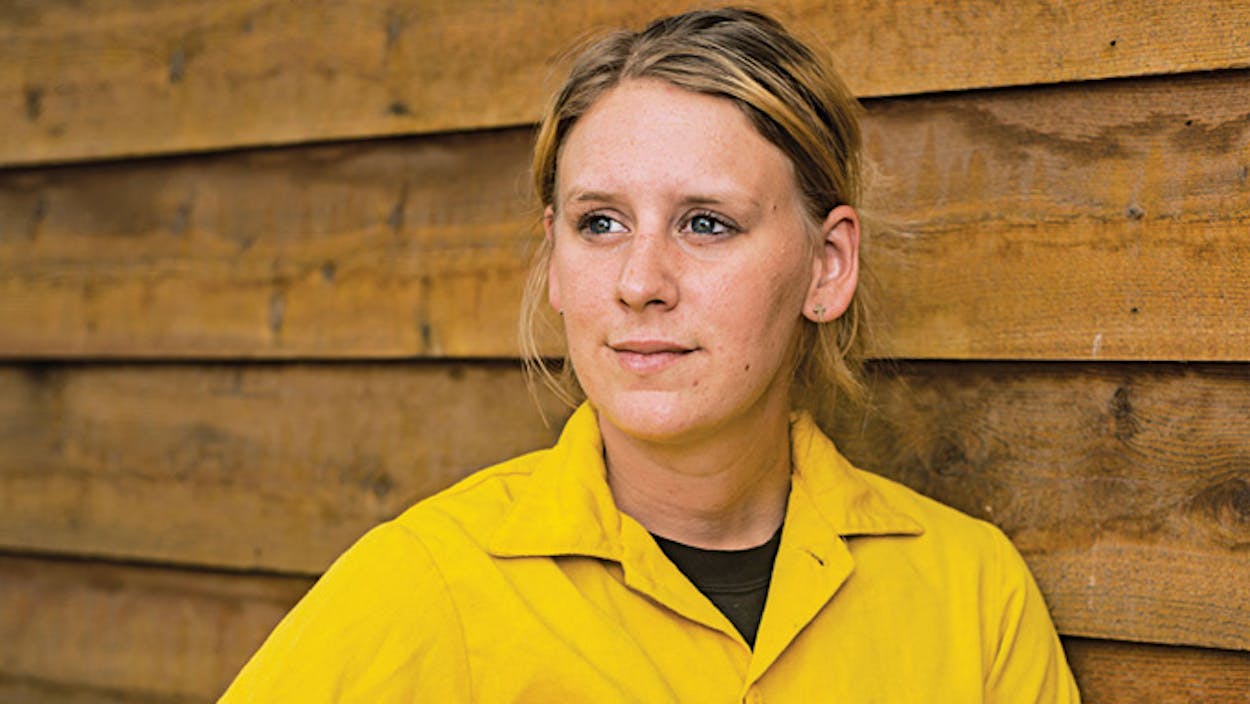Gray is a seasonal wildland firefighter who works in places like California and Colorado during the summer and with Lake Travis Fire Rescue, an emergency services district in Lakeway, just west of Austin, in the winter. In 2011, at age eighteen, she joined the Bastrop Fire Department as a volunteer firefighter and just a few months later helped battle the most catastrophic wildfire in Texas history.
I was standing outside my grandfather’s home in Austin when I first saw the huge black plume of smoke rising in the distance. It was September 4, 2011, Labor Day weekend. Wildfires had been burning across the state that summer, and the weather conditions were ripe for more. Less than a minute later, my phone buzzed with a text message from the Bastrop Fire Department. All firefighters were to report for duty ASAP.
At the time, I was juggling my volunteer work at the Bastrop Fire Department, a part-time job at a dog-boarding facility, and firefighting training courses. My father is a firefighter, so following in his footsteps seemed like a good thing to do. And I had helped quell my first real fire just four months earlier: an illegal burning of used tires that had gotten out of control. But it wasn’t until I experienced the chaos of the Bastrop County Complex Fire that I realized I wanted to specialize in fighting flames in the wildland-urban interface, the places outside cities where nature and development meet and where homes and businesses are nestled into hills, cliffs, and brush.
Some of the most devastating blazes in the state’s history hit Central Texas that September, but the Bastrop wildfire was the worst. Flames destroyed more than 1,600 homes and most of Bastrop State Park. My father, who fought the wildfire too, didn’t let me respond to the fire department’s alert right away; I guess he was worried it might be too dangerous for me. He made me wait with my grandfather until the second day.
Once I got out there, that fire turned my approach to firefighting upside down. I think the same thing happened to a lot of firefighters. We were used to dealing with fires in urban settings, inside residences or other buildings. We were used to going in quickly and completely extinguishing the flames, even when a home was in full bloom. You can’t do that out in the wildland, not when the fire is burning through the tops of the trees. And you don’t have the capability or the resources to save every property. You can only do so much, and you have to evaluate whether it’s possible to save a house. Sometimes it isn’t, and you have to walk away.
That’s one of the toughest parts of the job. It was especially tough in the Bastrop wildfire, because I was raised there, although I was born in Arkansas. It’s home to me and to many of the firefighters. The blaze never reached my house, but it was hard watching some of my fellow firefighters break down as the flames engulfed their own homes, knowing there was nothing we could do. Some residents were frustrated and didn’t understand that sometimes we had to wait and let the land burn. But we all did the best we could in the worst possible scenario. I truly think we prevented an even bigger, much more deadly catastrophe.
I’ve grown a lot as a firefighter since then. I now work as a fuels crew member with Lake Travis Fire Rescue in winters, responding to emergencies and aiding homeowners in wooded areas with wildfire prevention. I also take on seasonal work in other states, places that are prone to wildfires. But getting my foot in the door was tough. Last year, I started calling fire stations across the western United States about employment opportunities, and everyone required a lot of experience. I put in more than five hundred applications, and I finally got a call back from the U.S. Forest Service in the Plumas National Forest, in California. I worked with them last summer, from May to October. This summer, I’ve been working in Colorado with the Bureau of Land Management.
Firefighting out in the wildland-urban interface differs from firefighting in a city. We don’t always use water—or we have to be more conscious of how much we use and how we use it, since there are often no hydrants or lakes or creeks nearby. If the flames are too intense, it can be better to fight fire with fire, meaning that we build a bigger blaze with a firebreak to remove the combustible underbrush and get the original fire to stop at a certain spot. And sometimes we’re not fighting fires—we’re starting them. We select a parcel of land and set it on fire, controlling the flames, to help clear overgrown vegetation that could serve as fuel for wildfires. Fire is so destructive that many landowners don’t realize it can sometimes do good on their property. It’s a necessary part of the ecosystem. Homeowners who live in the interface can help us out by practicing controlled burns and keeping a protective space around their houses, free of shrubs and brush.
Experts predict that Central Texas is due for another massive wildfire, even larger than the one in Bastrop. That battle was tough, and we really didn’t know the magnitude of the forces we were up against. When the blazes broke out, crews responded from across the state. We worked with strangers, but we all knew how to follow the same rules. We became a team. And that’s what I love about it. As firefighters, we all know how to work together. We all speak the same language. Our bond is tight.
As told to Jazmine Ulloa on June 30, 2013







